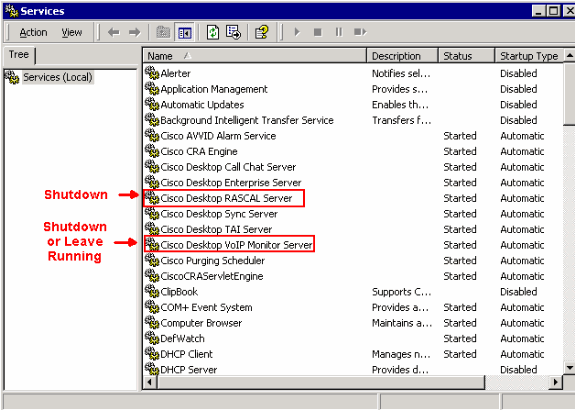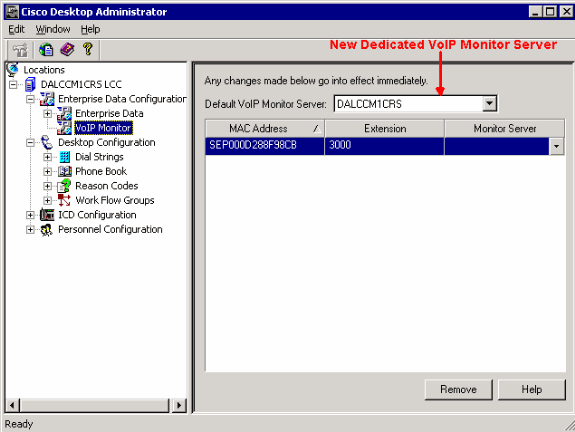Move RASCAL and VoIP Server from Co-resident CRS Server to a Dedicated Server
Available Languages
Contents
Introduction
This document describes how to move the Cisco Desktop RASCAL and VoIP server from a co-resident Cisco Customer Response Solutions (CRS) server to a dedicated Cisco Desktop RASCAL and VoIP Monitor server in a Cisco IP Contact Center (IPCC) Express environment.
This document assumes Cisco CRS server and Cisco Desktop Product Suite are co-resident.
Prerequisites
Requirements
Readers of this document should have knowledge of these topics:
-
Cisco CallManager
-
Cisco CRS
-
Cisco Desktop Product Suite
Components Used
The information in this document is based on these software and hardware versions:
-
Cisco CallManager version 3.x
-
Cisco CRS version 3.x
The information in this document was created from the devices in a specific lab environment. All of the devices used in this document started with a cleared (default) configuration. If your network is live, make sure that you understand the potential impact of any command.
Conventions
Refer to the Cisco Technical Tips Conventions for more information on document conventions.
Dedicated RASCAL and VoIP Server
If you run Cisco CRS Enhanced, one option is to set up a dedicated server to handle recording, voice monitoring, and maintain Integrated Call Distribution (ICD) statistics. A dedicated server can conserve CPU resources on the CRS server because the CRS server does not need to handle these functions. Before you implement these changes, read Appendix A in Getting Started with Cisco Customer Response Applications.
Complete these steps in order to move RASCAL and the VoIP server from a co-resident CRS server to a dedicated RASCAL and VoIP server:
-
Create a folder under the root directory on the new dedicated RASCAL/VoIP Monitor server.
-
Copy the original license file on the CRS server to the folder.
-
Run the CRS installation on the dedicated RASCAL and VoIP Monitor server.
-
When the Cisco Customer Response Applications Component Distribution window appears, select VoIP Monitor server and ICD Recording Server.
Note: Do not choose any other components.
-
Shut down the Cisco Desktop RASCAL and VoIP server services on the CRS server.
Note: You can leave the VoIP Monitor server service running on the CRS server.
Figure 1—Services
-
Run the Cisco Desktop Administrator on the new dedicated Cisco Desktop RASCAL and VoIP Monitor server in order to set the Default VoIP Monitor Server.
If your system has only one VoIP Monitor server, it is not necessary to set a default monitor server or to manually assign each device to that single monitor. The VoIP Monitor server assumes that each device is assigned to it as the only available monitor server. Select a default monitor server to avoid devices becoming unassigned to any monitor server. This can arise when there is more than one VoIP Monitor server in the system.
Note: Modifications made in the VoIP Monitor window go into effect immediately. For details, see section 2, Enterprise Data, in the Cisco Desktop Administrator User Guide.
Figure 2—Cisco Desktop Administrator - New Dedicated VoIP Monitor Server
Related Information
Contact Cisco
- Open a Support Case

- (Requires a Cisco Service Contract)


 Feedback
Feedback